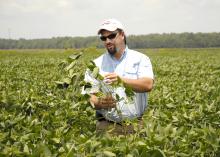Information Possibly Outdated
The information presented on this page was originally released on August 2, 2013. It may not be outdated, but please search our site for more current information. If you plan to quote or reference this information in a publication, please check with the Extension specialist or author before proceeding.
Soybean potential drives prices down
MISSISSIPPI STATE -- The spring’s planting challenges and last year’s Midwest drought boosted soybean prices for a while, but the winds of change are starting to blow.
Brian Williams, agricultural economist with the Mississippi State University Extension Service, said the soybean market had been strong until mid-July. The market typically drops before harvest, but he said prices dropped a bit faster this year.
“Soybean prices tumbled recently because the national crop is looking so much better than last year,” he said. “The majority of the crop in Mississippi and nationally -- about 63 percent -- is listed as good or excellent.”
Williams said growers, especially those in the Midwest, have been selling stored soybeans and other grains in advance of harvest, sending the market down more as supplies remain strong.
“Even with the drought last year, we had a better-than-expected crop once soybean harvest started,” he said. “The yield potential for this year’s crop is still uncertain. The next few weeks will be critical.”
The current August contract prices are around $13.75 per bushel. Although that is below last year’s prices of $16.50 to $17 per bushel, it remains above the five-year average of about $12.84.
“As prices have been strong, the cost of production has also increased in recent years,” Williams said. “Even with prices falling back, this remains a profitable crop.”
Extension soybean specialist Trent Irby said many fields had to be replanted last spring as excessive rains and cooler temperatures complicated the early season. Despite those challenges, the 2013 crop looks good, especially in irrigated fields.
“Counties in the east-central part of the state saw some timely rains during July,” he said. “Showers across the rest of the state have been scattered with many farmers relying on irrigation.”
Irby said the crop remains about three weeks behind normal.
“Usually, the majority of the state’s crop would be setting pods by Aug. 1, but only about 50 percent of the acreage is at that point now,” he said. “Over the years, our growers have seen many benefits from planting early. Typically, the stresses from insects and diseases are not as severe with early plantings. Conditions just didn’t allow us to get the crop started as early this year.”
Irby said that up to this point, insect and disease pressures have been relatively light, but those issues are picking up -- also later than normal.
“An increase in disease pressure will likely depend on the weather in the upcoming weeks. The impact that a disease has on soybean yield can depend on environmental conditions as well as the stage of the crop,” he said. “Our pathologists are watching closely for soybean rust as well as other diseases. So far, five counties in the southern part of the state are reporting cases of soybean rust in sentinel plots. Growers need to continue to watch closely for these issues, particularly with such a late crop.”
Insect issues also need to be monitored closely as the crop approaches maturity.
Extension entomologist Angus Catchot said kudzu bugs, which arrived in the state in 2012, are presenting additional challenges for soybeans. Growers may have another year before populations warrant treatments.
“We’re up to 17 Mississippi counties with kudzu bugs, seven of those with them in soybean fields,” Catchot said. “They made a big move this year but haven’t yet reached treatable levels in soybeans. I feel certain that we’ll be treating a few soybean fields next year.”
Catchot said the highest kudzu bug numbers are found around Warren County and in southwest Mississippi.










